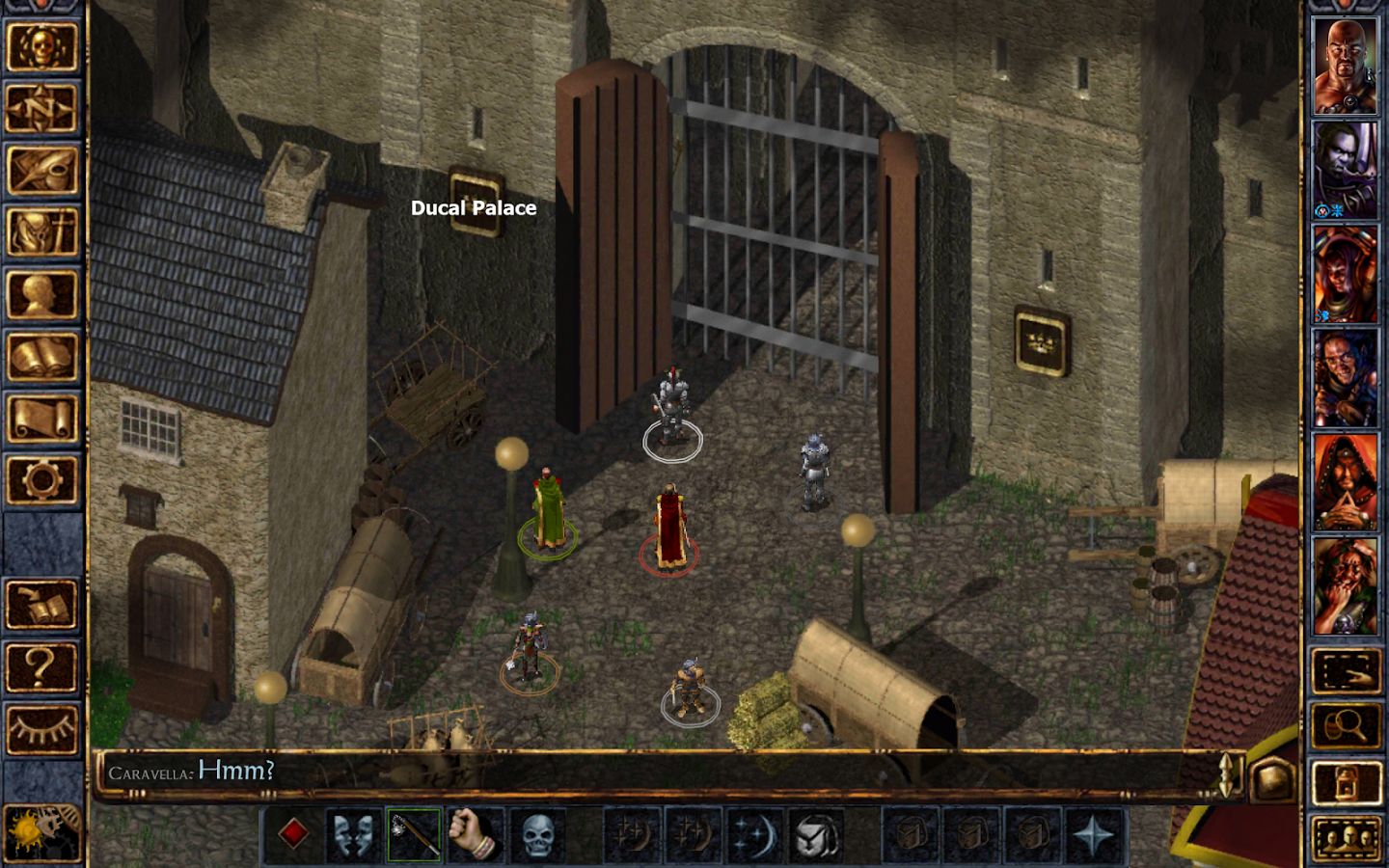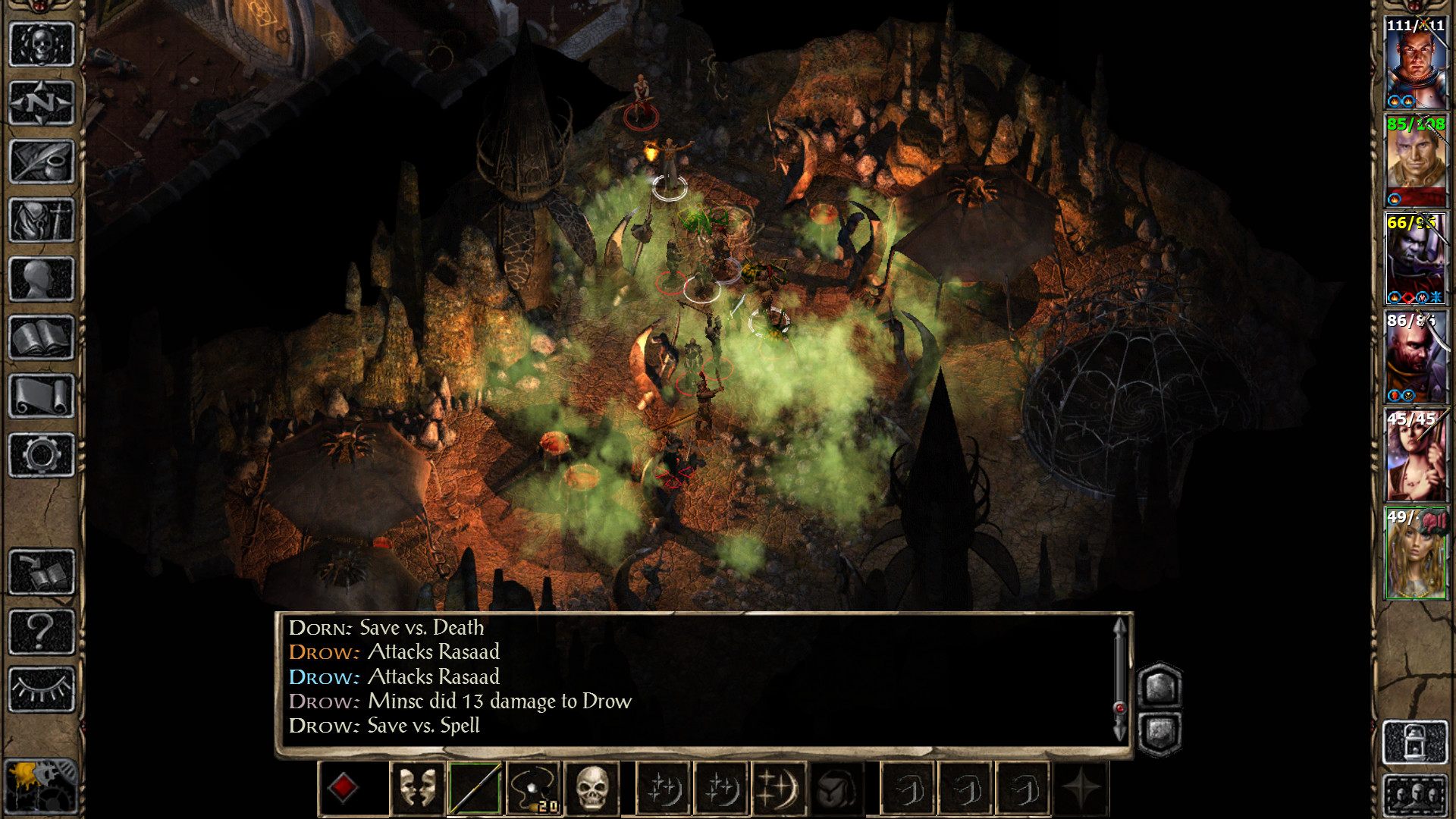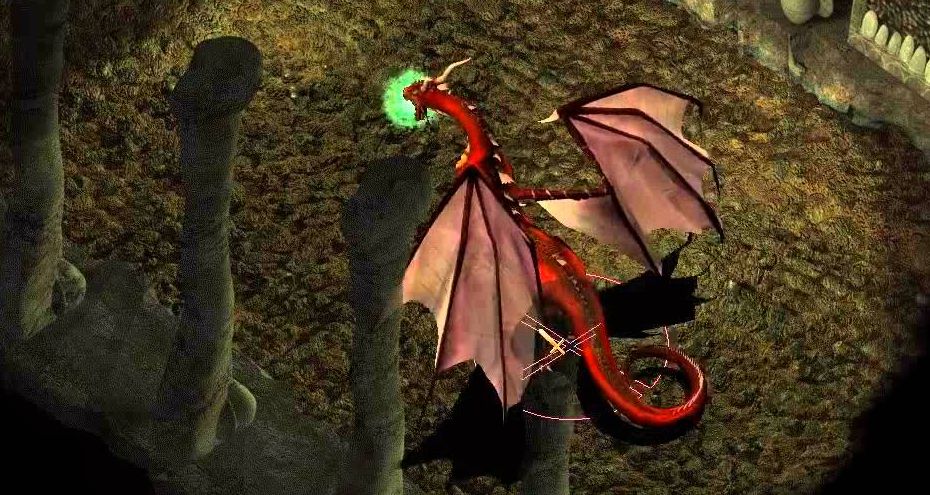The history of Baldur's Gate
Join us as we return to one of the most troubled towns in the Forgotten Realms.

This article was originally published in issue 188 of Retro Gamer. Here's everything we know about Baldur's Gate 3.
Formed in 1995 by three doctors, Ray Muzyka, Greg Zeschuk and Augustine Yip, Edmonton-based BioWare is today one of the most respected videogame developers in the world. With the trio of founders all holding a keen interest in games and Dungeons & Dragons, the creation of a videogame RPG was inevitable. An early BioWare employee, and key part in the development of Baldur’s Gate, was designer James Ohlen. “Myself and a group of friends were among the first employees at BioWare,” James recalls, “and we all drove down to Edmonton for the interview. They told us they were working on a D&D game, although they didn’t know what it was going to be yet.”
In the meantime, BioWare had negotiated a deal with Interplay Productions for a mech-style game entitled Shattered Steel; coincidentally, the publisher had also acquired use of the Dungeons & Dragons tabletop RPG, and looked to its new partner to produce a game based round the TSR property. BioWare co-opted Battleground Infinity, a prototype real-time strategy game from coder Scott Greig, and used its engine as the base for the new RPG. “Scott had his engine and there were a dozen of us in total,” continues James. “Ray and Greg were negotiating with Interplay this game based on D&D, and originally it was called Iron Throne. Of course, there were a lot of iron throne toilet jokes, before Brian Fargo [Interplay founder] came up with the name Baldur’s Gate.”
Baldur’s Gate had become the central focus at an early stage as TSR wanted Interplay to create an RPG based around the Forgotten Realms. At the time it was the most popular D&D campaign setting, and it also featured a mass of material from which BioWare could draw from, with the downside being a relatively small area in which to base the game. The main city and focus of this area was its title; then all it needed was a lead designer at the helm. “When people ask me how did I become a lead designer, I say I decided I was gonna be one, went away, did all the work, and they said, ‘You’re the lead designer!’” laughs James. “If you’re passionate about something, pursue that, and Dungeons & Dragons had been in my life since I was 11 years old. Baldur’s Gate was the chance for me to present what I thought would be a great Dungeons & Dragons style RPG.”
I played Warcraft 2 and Starcraft more than you can imagine.
James Ohlen
In addition to James, almost every employee at BioWare was also a fan of the famous tabletop game. While this passion is clearly evident in the finished games, at the time none of the team actually had any programming or art experience. But they knew how to create an evocative story, they knew all about RPGs, and they knew exactly the sort of game they wanted to play. James continues, “I’ve always felt that you can go too far in the story direction, and also too far in the exploration and combat direction. If you marry those together, you get something that gets the power gamers involved in the story, and the story gamers involved in the combat and tactics—get them both to appreciate the sides they don’t normally do.” BioWare would later build its reputation on the power of storytelling—think Star Wars Knights Of The Old Republic, Mass Effect and Dragon Age—and that began with Baldur’s Gate, over 20 years ago.
Baldur’s Gate is the story of a mage named Gorion and his young orphan charge, controlled by the player. Along with childhood friend, Imoen, the orphan grew up in Candlekeep, a walled fortress situated just south of the fabled titular city. The mystery begins with the player ushered out of their home by Gorion, who refuses to reveal the reason for the hasty exit. Upon leaving, they are ambushed and Gorion is murdered; soon the player is embroiled in a political imbroglio while investigating a chronic iron shortage and trying to discover who is behind the death of their guardian. It’s an intriguing and absorbing tale that leads to some surprising revelations and fascinating characters. Yet depth of story alone was not what sold Baldur’s Gate to the masses.
For years, RPGs had remained, typically, stoically turn-based, even with popular series such as Interplay’s own Fallout. And turn-based fans, like it or not, this method of play was what many perceived as holding the genre back. Baldur’s Gate became a bridge between turn-based and real-time, the old and the new, unfashionable and the fashionable. “That was me and Ray [Muzyka],” remembers James. “Ray was a big fan of turn-based games, the Gold Box games, and my favourite genre was real-time strategy—I played Warcraft 2 and StarCraft more than you can imagine. So it came from having to have a real-time game that satisfied fans of that genre, but also satisfied turn-based fans.”
Keep up to date with the most important stories and the best deals, as picked by the PC Gamer team.

The result was tactical pause, where the player could pause the action before and during a battle, allocate weapons, target enemies and even quaff potions to buff up their party members. Then you’d unpause, and let the decisions take effect, for better or worse. “Maybe I shouldn’t say it,” reveals James nervously, “but I was never a fan of Fallout and Fallout 2. I liked the story and the world, but the fact it paused and took turns for moving, I never liked that. RPGs are about immersing you in their world, so the closer you get to the feeling of real, the better.” Despite James’ convictions, the decision was not met with universal praise; but his philosophy paid off when Baldur’s Gate was released to almost total acclaim and sales far in excess of Interplay’s expectations.
As Baldur’s Gate sold in its thousands around the world, sucking gamers into a time warp where suddenly it was 3am in the morning and they were still engrossed in its world, BioWare was already at work on its expansion. “We were always going to have Tales Of The Sword Coast,” says James. “It wasn’t left over material, we just needed an expansion to make extra money.” Given no one had any idea how big Baldur’s Gate was going to be, the add-on was a little by-the-numbers. “It wasn’t much, as we didn’t stretch ourselves. It was okay, but Baldur’s Gate II was when we knew we had to have something that would blow everyone away.”
BioWare’s original plan for Baldur’s Gate was as ambitious as we’ve come to expect from the developer. “From the very beginning, the plan was to have a trilogy,” reveals James, “so we wanted the player to be able to create a character not just for the first game but the entire trilogy.” For those fans frustrated by the experience/level cap in Baldur’s Gate, now you know why. “Yeah we just couldn’t let the player have all the levels from the beginning—we were thinking if we could do as half as well as Fallout, we could do three games, making what we loved.”
Baldur’s Gate and its add-on were delivered a year late to Interplay; but it was still an instant smash, though. “The thing about Ray [Muzyka] and Greg [Zeschuk] was that they were smart men,” continues James. “They were very humble and created a culture within BioWare that was also very humble. So it was all collaboration and the best idea wins out. Sure, there were heated arguments, as always, but we all wanted to make a great Dungeons & Dragons game, so were always focused towards the same goal.”
Despite the group’s singlemindedness, there were inevitably minor faults within Baldur’s Gate. Pathfinding, a constant bugbear of games even today, was far from satisfactory, with the player’s party often prone to wandering through a giant spider nest rather than that safe route you’d carefully selected. And by self-admission, James realised his characters weren’t quite as fully developed as they could have been.
“I was talking to Dermot Clarke, who was a go-between between us and Interplay. I was high on the success of Baldur’s Gate, including our story and characters. He told me they weren’t really as well-developed as the characters in Final Fantasy VII.” Between Baldur’s Gate and its sequel, James played straight through the famous Squaresoft game, enthralled by the game’s depth of character, from backstory, to interaction and romance. That’s right, BioWare’s famous (and sometimes infamous) romance systems began with the Final Fantasy series.

Baldur’s Gate II continues the story of who we now know as the half-sibling of the first game’s main antagonist, Sarevok, and fellow child of the Lord Of Murder, Bhaal. At the start of the game, the spawn of Bhaal and a handful of party members are imprisoned within a dank dungeon. Their host is Jon Irenicus, an evil mage who has discovered the nature of the lead character, and tortures them in a vain attempt to tap the power of the God Of Murder. Throughout the city of Athkatla and the lands south of Baldur’s Gate, the game concludes in the Elven city of Suldanessellar, where the player must battle the mage and also, themselves, in order to save the city and their own soul. “As soon as we’d finished Sword Coast, we began on Baldur’s Gate II,” remembers James, “although we didn’t have much sketched out beyond the fact we were going to do a Highlander-style storyline where the last spawn of Bhaal standing would become the new God.”
The sequel also boasted a superior screen resolution, an improved multiplayer experience (the game would no longer pause when one character entered a building for example) and a new pathfinding technique called ‘bumping’ which allowed characters to jump out of the way rather than block their teammates. Inspired by Final Fantasy and Chrono Cross, the characters themselves improved immeasurably says James. “We gave each companion character an entire storyline, added romance options and more fleshed-out relationship arcs. And the Forgotten Realms is a huge world, so just sticking to the area around Baldur’s Gate didn’t feel right.” The sequel’s expansion, Throne Of Bhaal, effectively replaced the proposed third Baldur’s Gate game as far as BioWare was concerned, although Interplay itself continued the idea together with Black Isle Studios.
After the critical acclaim and success of Baldur’s Gate II, BioWare, loathe to move away from the roleplaying genre for which it had now made its name, began pitching alternative stories to Interplay based on the Forgotten Realms setting, utilising a new game engine. As attractive as the Infinity Engine was, its time had clearly come, and Neverwinter Nights was the next proposed chapter. Sadly, Interplay’s money troubles were never far away, and it was eventually published by Infogrames, under its Atari label. But elsewhere, the Baldur’s Gate story was taking a new direction, one that would reach a new audience once more, away from the dedicated PC fanbase.
Dark Alliance was always presented as an action-RPG title with minimal dialogue.
Chris Avellone
Despite the cancellation of the PlayStation port of Baldur’s Gate, Interplay didn’t abandon the idea of a console version of its famous series. With franchise rights held by the publisher and, in any case, BioWare busy with Neverwinter Nights, a completely new story and style of gameplay was pitched for the PlayStation 2 console, a market that was proving too large to ignore. Within the publisher, and its in-house developer, Black Isle, there was a feeling that it was lagging behind in terms of console titles. “Console game sales during that period were a big part of the business,” explains Chris Avellone, co-designer on the first game in this fresh direction. “And the fact that Interplay and Black Isle didn’t have titles in the console space was setting the company back. Dark Alliance was intended to combat that.”
While a game in the style of the original Baldur’s Gate could have worked, a focus on combat, exploration and linear gameplay was what Interplay decided would work best in terms of its chief motivation: sales. “I did have the concern that by using the Baldur’s Gate name, it would have the connotation that it was a deep role-playing game, and it also implies a strong city connection,” continues Chris. “To me, however, Dark Alliance was always presented as an action RPG title with minimal dialogue, which made sense.”
To help develop the new title, Washington-based Snowblind Studios was contracted by Interplay, together with its impressive eponymous engine. “Like BioWare, they were an independent studio,” says Chris, who worked with Snowblind closely during development. “I liked its studio director, lead programmer and everyone I met there. They were capable of developing the engine and tech where we couldn’t do so internally.” The Snowblind engine presented a top-down isometric view of the action, with a fully rotatable camera, and enabled two players to battle together within the game’s locations. “It was pretty smooth, and multiplayer was fun and easy to hop in and out of,” recalls Chris. “And this will sound crazy, but the water physics in the game made it fun just to run around in the water—you could literally boot up a level and have fun jumping and running circles in the water.”
Unfortunately, for many Baldur’s Gate fans, the payoff was a plot and characterisation that was as shallow as many of the puddles that were so enjoyable to jump into, with little motivation or story behind its three lead characters. Black Isle, as with the other games, supported development where it could, as Chris explains. “Our support for Dark Alliance was largely me on narrative production and QA. In short, I made suggestions, but mostly worked on the script.”

Dark Alliance is the tale of three adventurers, each with unique abilities and weaknesses. Human Vahn is an archer, adept at eliminating enemies with his enchanted arrows, yet weaker at melee combat. Adrianna is an Elven sorceress, with the ability to unleash devastating magical attacks, while Kromlech, the obligatory stout dwarf, delights to engage in hand-to-hand combat, preferably with a battleaxe or mountainous sword. Each character must take on the Dark Alliance, a mass of evil created upon the death of Eldrith The Betrayer, a Sword Coast commander tainted by the poison of foolish pride. In a maddened frenzy, Eldrith gathered her forces to attack Baldur’s Gate, a vainglorious attempt to seize the walled city. It failed, and with her dying breath she cursed it, and all who lived inside. Now, as one or two of the three characters, the player must take on the perils of Baldur’s Gate and save the city from the resurrected evil of Eldrith and her devilish Dark Alliance.
The story of Dark Alliance serves to move the action swiftly from one location to another, with frequent pit stops at the city itself, usually to rearm and flog all the spoils from the various battles. Gameplay is streamlined so that the experience rarely became onerous. Recall potions allow the player to warp straight back to the Elfsong Tavern where they can sell items and weapons, pick up new gear and learn of potential new missions. Each location presents a linear procession from one point to another, killing anything in the way, and saving at the frequent save point altars. The game’s simplicity (which also includes a truncated level-up system) nonetheless hit the spot with console gamers more orientated towards action-heavy games.
Dark Alliance taught me that trying to finish your work early at Black Isle just opened you up to more revisions.
Chris Avellone
“The story wasn’t balanced well,” bemoans Chris, “with too much coming out towards the end. But even though I wasn’t happy, it could have been worse. Dark Alliance taught me that trying to finish your work early at Black Isle just opened you up to more revisions. I remember writing a pass of the storyline, being pleased with it, then suddenly the studio head and others at Interplay began a series of bizarre suggestions about what they thought would work story-wise.” In the case of Dark Alliance, there’s no doubt that the tenet ‘less is more’ applies. Its levelling up, frequent battles (even more fun in co-op) and looting require just a loose framework of story to hang on over its relatively short running time. “I thought there were just enough levels to make each new area you encountered exciting without the player getting exhausted of the area you were just at,” notes Chris. “I think if we’d dragged out the environment levels, people would have gotten tired of them.”
The success of Dark Alliance on the PlayStation 2 led to subsequent releases on the Xbox and GameCube. While these differed little—the Microsoft console improved the visuals slightly, with the latter console going the other way—the Game Boy Advance port three years later offers a substantially different experience. Gone is the, frankly unnecessary, jumping mechanic, along with the experience meter, and most of the game’s conversational choices. Smaller levels and a more interactive Baldur’s Gate (the player can talk to most of its populace, and even take on minor side missions for them) help make this version just as enjoyable, despite its brevity. Only the lack of recall potions and character choice counts against it, although the ability to save the game whenever you want to is a welcome addition.
On the next page: Dark Alliance, and the original plans for Baldur's Gate 3.

